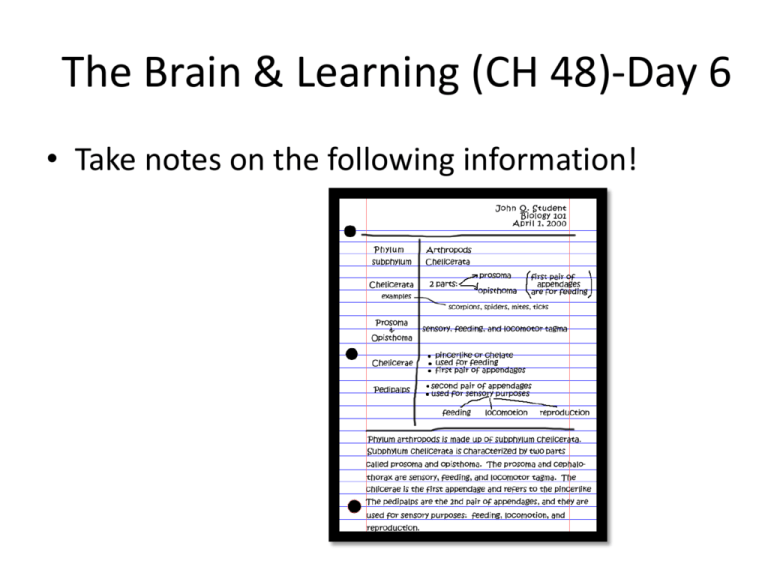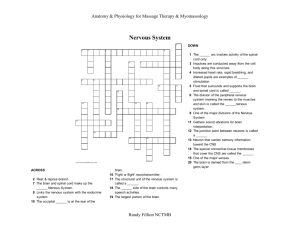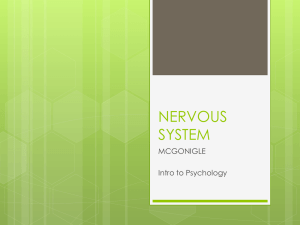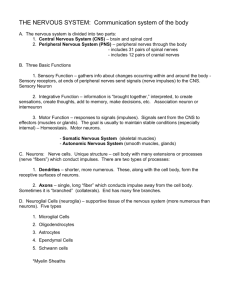The Brain & Learning (CH 48)
advertisement

The Brain & Learning (CH 48)-Day 6 • Take notes on the following information! • All animals except sponges have a nervous system. • What distinguishes nervous systems of different animal groups is how neurons are organized into circuits. Chordates Echinoderms Arthropods Roundworms Annelids Mollusks Flatworms Radial Symmetry Cnidarians Pseudocoelom Radial Symmetry Sponges Protostome Development Three Germ Layers; Bilateral Symmetry Deuterostome Development Coelom Tissues Multicellularity Single-celled ancestor The animal kingdom Organization of Nervous Systems • The simplest animals with nervous systems, the cnidarians, have neurons arranged in nerve nets The cnidarians, have neurons arranged in nerve nets Radial nerve Nerve net Hydra (cnidarian) Nerve ring Sea star (echinoderm) Sea stars have a nerve net in each arm connected by radial nerves to a central nerve ring •simple cephalized animals, such as flatworms, •have a central nervous system (CNS) Eyespot Brain Brain Nerve cord Transverse nerve Planarian (flatworm) Ventral nerve cord Segmental ganglion Leech (annelid) Annelids and arthropods have segmentally arranged clusters of neurons called ganglia. These ganglia connect to the CNS and make up a peripheral nervous system (PNS). Ganglia Brain Ventral nerve cord Segmental ganglia Insect (arthropod) Anterior nerve ring Longitudinal nerve cords Chiton (mollusc) In vertebrates, the central nervous system consists of a brain and dorsal spinal cord. The PNS connects to the CNS. Brain Brain Ganglia Squid (mollusc) Spinal cord (dorsal nerve cord) Sensory ganglion Salamander (chordate) Information Processing Nervous systems process information in three stages: sensory input, integration, and motor output Integration Sensory input Sensor Motor output Effector Peripheral nervous system (PNS) Central nervous system (CNS) • Sensory neurons transmit information from sensors that detect external stimuli and internal conditions • Sensory information is sent to the CNS, where interneurons integrate the information • Motor output leaves the CNS via motor neurons, which communicate with effector cells • The three stages of information processing are illustrated in the knee-jerk reflex Quadriceps muscle Cell body of sensory neuron in dorsal root ganglion Gray matter White matter Hamstring muscle Spinal cord (cross section) Sensory neuron Motor neuron Interneuron Neurons have a wide variety of shapes that reflect input and output interactions Dendrites Axon Cell body Sensory neuron Interneurons Motor neuron Central nervous system (CNS) Brain Spinal cord Peripheral nervous system (PNS) Cranial nerves Ganglia outside CNS Spinal nerves Brain Cells are Neurons... Dendrites Cell body Nucleus Axon hillock Axon Presynaptic cell Signal direction Synaptic Myelin sheath terminals Synapse Postsynaptic cell • • • • cell body: contains nucleus & organelles dendrites: receive incoming messages axons: transmit messages away to other cells myelin sheath: fatty insulation covering axon, speeds up nerve impulses • synapse: junction between 2 neurons • neurotransmitter: chemical messengers sent across synapse • Glia: cells that support neurons – Eg. Schwann cells (forms myelin sheath) Supporting Cells (Glia) • Glia are essential for structural integrity of the nervous system and for functioning of neurons • Types of glia: astrocytes, radial glia, oligodendrocytes, and Schwann cells In the CNS, astrocytes provide structural support for neurons and regulate extracellular concentrations of ions and neurotransmitters Green cells are the astrocytes. Blue stains the nucleus. Oligodendrocytes (in the CNS) and Schwann cells (in the PNS) form the myelin sheaths around axons of many vertebrate neurons. Nodes of Ranvier Layers of myelin Axon Schwann cell Axon Myelin sheath Nodes of Ranvier Schwann cell Nucleus of Schwann cell 0.1 µm Synapse…. • SYNAPSE: where a nerve cell touches another nerve cell (or muscle cell, etc). • Brain uses synapse to send/receive signals Central Nervous System • Brain and spinal cord • Cavities are filled with cerebrospinal fluid – cushions and supplies nutrients and white blood cells. – Meninges are layers of connective tissue surrounding the brain and spinal cord • White matter is myelinated; gray matter is not. • Evolutionarily older structures in the brain regulate essential functions. Peripheral Nervous System Cranial nerves originate in the brain and terminate mostly in organs of the head and upper body. Spinal nerves originate in the spinal cord and extend to parts of the body below the head The PNS has two functional components: the somatic and autonomic nervous systems Peripheral Nervous System • Somatic nervous system (PNS): – Voluntary (conscious control) – Carries signals to skeletal muscles • Autonomic nervous system (PNS) – Involuntary – Smooth and cardiac muscle, GI , cardio, excretory and endocrine organs MOTOR DIVISION Peripheral nervous system Somatic nervous system carries signals to skeletal muscles Sympathetic: speeds up everything but digestion “fight or flight” adrenaline Autonomic nervous system Sympathetic division regulates the internal environment in an involuntary manner Parasympathetic division Enteric division Parasympathetic calms everything but digestion PNS Divided into 2 Parts • Sympathetic division – speeds up everything but digestion – “fight or flight” – adrenaline • Parasympathetic division – calms everything but digestion Embryonic Development of the Brain All vertebrate brains develop from three embryonic regions: forebrain, midbrain, and hindbrain Brain structures present in adult Embryonic brain regions Telencephalon Cerebrum (cerebral hemispheres; includes cerebral cortex, white matter, basal nuclei) Diencephalon Diencephalon (thalamus, hypothalamus, epithalamus) Forebrain Midbrain Mesencephalon Midbrain (part of brainstem) Metencephalon Pons (part of brainstem), cerebellum Myelencephalon Medulla oblongata (part of brainstem) Hindbrain Mesencephalon Metencephalon Cerebral hemisphere Diencephalon: Hypothalamus Thalamus Midbrain Hindbrain Diencephalon Myelencephalon Pineal gland (part of epithalamus) Brainstem: Midbrain Pons Spinal cord Forebrain Telencephalon Pituitary gland Medulla oblongata Spinal cord Cerebellum Central canal Embryo at one month Embryo at five weeks Adult BRAIN This white matter is distinguishable from gray matter, which consists mainly of dendrites, unmyelinated axons, and neuron cell bodies Gray matter White matter Ventricles BRAIN in the CNS has different parts. Brainstem Hindbrain Pons Medulla oblongata HOMEOSTASIS…… breathing, heart activity, swallowing, vomiting, digestion; most ascending axons cross over here Cerebellum coordination and motor learning Cerebrum • Right and left hemispheres connected by corpus callosum Cerebral cortex (gray matter) is the largest and most complex part of the mammalian brain Cerebrum Cerebrum Frontal lobe: speech, personality, motor cortex Parietal lobe: somatosensory cortex, speech, taste, reading Temporal lobe: hearing, smell Occipital lobe: vision Language and Speech • Brocca’s area – Frontal lobe – Patients with injury can understand language but not speak • Wernicke’s area – Temporal lobe – Patients with injury can speak but not comprehend Diencephalon Hypothalamus Thalamus Pituitary gland Hypothalamus: homeostasis by regulating hunger, thirst, temp., circadian rhythms Pineal gland Thalamus: relay center Circadian Rhythms • The hypothalamus also regulates circadian rhythms such as the sleep/wake cycle • Animals usually have a biological clock, a pair of suprachiasmatic nuclei (SCN) in the hypothalamus • Biological clocks usually require external cues to remain synchronized with environmental cycles PET scan Magnetic resonance images (MRI) The limbic system: emotions and memory including olfaction Memory and Learning • The frontal lobes are a site of short-term memory • They interact with the hippocampus and amygdala to consolidate long-term memory • Many sensory and motor association areas of the cerebral cortex are involved in storing and retrieving words and images Learning • How does an organism learn about it’s environment? – Taxis: purposeful movement • Toward stimulus = + taxis • Away from stimulus = - taxis – Kinesis: random movement • Hoping for the best Cognition • Cognition means to know/learn and that you are being aware. – Environment + genes • Metacognition = aware of how you learn – Learning Styles Diagram of Brain • • • • • • Tap into your creative side using pictures, sketches and words to form a collage in each section of the brain to represent the functions of these lobes. Frontal lobe -- Involved with planning, interpretation, emotions, personality, deliberate movements, decision making, and turning thoughts into words. Parietal lobe -- Perceives sensory inputs and and also associates these inputs with past memories. Temporal lobe -- Deals with the senses of smell and sound and also is responsible for forming memories. Occipital lobe -- Decodes images and objects that are seen in order to identify or recognize them. Cerebellum -- Regulates movement, balance and coordination. – For example, in the frontal lobe section, drawings of people smiling, crying or communicating can be utilized. – In the parietal lobe section, images representing the five senses can be pasted.









